Morritt is the 2nd Officer standing from the left rear row. The sword in the photo is the one shown on these pages.
Douglas Haig's account
(from a letter to his sister, Henrietta, 22 September 1901)
'You will have heard ere this of the terrible losses C Squadron 17th Lancers sustained on Tuesday last. I trained the regiment from Stormberg to Tarkastad to head Smuts' commando which had broken SW from near Dordrecht, The Squadron in question under a most capable officer (Sandeman) was holding a position about 14 miles [22,5km] from Tarkastad to prevent the enemy coming south. I was out with the squadron on the previous day (Monday) when it marched from Tarkastad. The weather for several days had been terribly wet. However it cleared for an hour about 3 o'clock and Sandeman lunched with me (off some of those nice tin things you sent me from Cabbett) on the fatal koppie on which next day so many poor fellows were killed. I got back to Tatkastad at 9pm. Next moming was very foggy. However his patrols reconnoitred the two passes at the exits of which Sandeman had his camp. All was reported clear, but about noon a message was sent to Sandeman that the Boers were advancing to attack his camp. A troop moved out at once. The officer in charge of it saw some men in khakee [sic] whom he took to be some of Gorrige's column which was expected north of the post. These men levelled their rifles at him when about 200 yards [180m] distant. He shouted to them 'Don't fire. We are the 17th Lancers.' (These irregular corps often fire at one another by mistake.) The Boers, as such they proved to be, opened fire at once and emptied several saddles. Before the troop got back to camp the enemy had worked up a donga to the rear of the camp. Again their khakee [sic] dress assisted them. They were now between Sandeman's squadrons and another squadron which was about three miles [4,8km] distant. Seeing khakee [sic] dressed men in rear of camp, they were allowed to approach quite close before fire was opened on them. Our men held the position to the last, and not a man surrendered. Out of 130 men, 29 were killed and 41 wounded. The other men were still fighting when the next squadron came to their support and the enemy made off. All the office s were either killed or wounded. Such nice fellows too.'(from a letter to his sister, Henrietta, 22 September 1901)
The opening of the Battle of Modderfontein
(taken from the excellent writeup by RW Smith 2004)
Russel's troop came across Ben Bouwer's group at a stream and a patch of thorn bush. The Boers levelled their rifles at the Lancers and Russel, believing them to be from Gorringe's column, shouted to them: 'Don't fire. We are the 17th Lancers.' (See H W Wilson's After Pretoria, Vol II, 1902, p 745). The Boers opened fire at once and the Lancers suffered several casualties. Realising that they were Boers, Russel sent some of his men back to camp along the road while he circled around to the west with the rest of the troop. The men that he had sent back to camp were delayed by a gate and suffered several more casualties (Reitz, 1929, p 226).
Reitz was one of those who had opened fire at the stream. He had dismounted and, as he had no more cartridges for his Mauser, he dropped it there, picked up a Lee-Metford and a bandolier from one of the Lancer dead, rushed for his mare, and joined in the chase after the Lancers' patrol. At the gate in the fence, Ben Bouwer and Jaap van Deventer conferred and then Bouwer and his men, who included Reitz, followed the retiring members of the patrol (Reitz, 1929, p 226).
Bouwer, Reitz, Veldkornet Jack Borrius and about a dozen others made their way up the eastern side of the valley, which is flat and open. Borrius took his men into the rocks and bushes of the dyke. Hidden in the rocks were the two guns - a mountain gun (popular in India, a muzzle-loader that could be quickly dismounted and carried by four or six mules) and a Maxim machine gun. Reitz and his friends dismounted and abandoned their horses. (Boer horses were trained to stand still and did not need minders). They found themselves very near the British gunners and quickly opened fire on the guns which were in an exposed position although protected by a ring of rocks. Lieutenant Hay-Coghlan was shot by Reitz, two of the other gunners were killed and another, who managed to escape into the camp, was wounded. They were also very close to the tents of the camp and were in a tight position. (This account differs in a number of important respects from the description given in Shearing [2000, p 55]. The account in Stretton [2001, pp 49-53] seems more plausible).
Commandant Ben Bouwer then arrived just behind Borrius' section, dismounted and ran into the yard of the farmhouse on its south side. The guard at the door opened fire and hit young Lawrence Tyner in the head. Meanwhile, Bouwer's men had spread out in a line to the south of the farmhouse and opened fire on the Lancers' right flank. Van Deventer had circled around even further to the south and approached the farm from that direction. Bouwer's men were already engaging the Lancers, who, it appears, mistook the oncoming Boers for their colleagues of 'A' Squadron, who were camped at Hoogstede to the south of Modderfontein. By then, Smuts and Kirsten had taken up a position on a small rise about 800 yards (730m) to the west and, from this point, swept the flat field with rifle fire. The Lancers were assailed from all sides, without adequate cover, and suffered accordingly.
When a patrol from 'A' Squadron of the Lancers was spotted in the distance, the Boers on the side of the dyke realised that they would have to finish things quickly before Lancer reinforcements arrived. Reitz and his fellow Boers probably saw van Deventer's men approaching and made the same mistake as the Lancers! Borrius gave the orders and Reitz and his section charged into the remaining Lancers, of whom there were only about fifteen left. Further resistance was hopeless, one or two threw down their arms, but several escaped into the tents. Reitz shot an officer who tried to escape on a horse, possibly Lieut Russel or Morritt? (Reitz, 1929, p 229).
With the guns out of action, the rest of the Lancers were quickly overwhelmed. Capt Sandeman rallied some of he men who occupied one of the stone kraals, but they were too few in number to defend the whole perimeter and they too were attacked from all sides, having no alternative but to give in. A number of Lancers were forced to retreat to the south through the narrow defile at Thorn Grove. Bouwer states that the action took 'less than twenty minutes', but in view of the serious opposition that the Boers encountered from the Lancers, it does seem unlikely that matters were decided quite so quickly. Both J P Bosman and Micholls describe what appears to be a small number of Lancers caught in the open on the right and forced to retreat through a defile, possibly near Thorn Grove Farm, 'after shooting their horses, ... having expended all their ammunition' (Micholls).
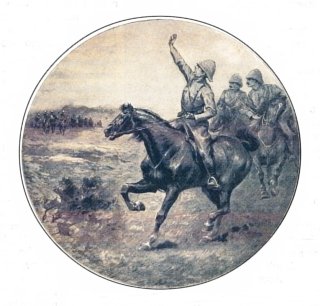
Don't fire! We are the 17th Lancers'
(Sketch by I Sheldon Williams, After Pretoria,
Vol II, p 744).
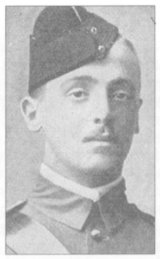
Lieut P H Hay-Coghlan, who died of wounds two
days after the battle (After Pretoria, Vol II).
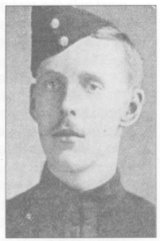
Lieut R B Morritt may have been the officer
shot while trying to escape (After Pretoria II).
There were about three hundred animals, horses and mules, in the Lancers' camp, some of which would have been killed and wounded in the fight. There would almost certainly have been enough surviving animals, however, to remount the commando. Apart from the Arab mentioned above, Reitz also managed to acquire a mule. When they had left De Hoek, the commando had had a string of dismounted men, as well as several wounded. No wounded were left behind at Modderfontein, although there were six more casualties. An eye witness account, given in Parry, quotes Commandant [sic] Smuts as having said that they 'had paid dearly for it'. The wounded were taken to Cradock, where there was a Red Cross hospital.
The Lancers' mountain gun had been disabled by a few blows from van Deventer (formerly a gunner in the Transvaal Staatsartillerie), who then rode off to the north through the Elandsrivierpoort and over Klein Mosterts Hoek pass towards Maraisburg (now Hofmeyr). Two Maxim guns had also been captured, but, according to Bouwer, these were too much of a nuisance and were dumped in the first dam they came across.
The patrol from 'A' Squadron was not sufficiently strong to do more than exchange a few shots with the fleeing Boers. They did what they could to rescue the few unwounded Lancers and sent messages back to their camp at Hoogstede. From there, a messenger galloped to Tarkastad, where Haig had two further Lancer squadrons, the news reaching him at 16.30. Haig then galloped the 22km to Modderfontein in an hour and a quarter, probably arriving there at 17.45, certainly too late to take part in the pursuit of the commando. The wounded were taken into Tarkastad. (It is claimed that two of them are buried in the town cemetery, but the writer was unable to confirm this).
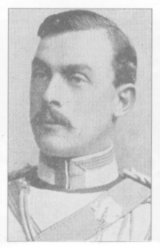
Lieut R B Sheridan, shot
through the brain by Jack
Borrius (After Pretoria II).
The Lancer camp was located in a less than ideal place for defence purposes. They had encamped there on arrival in the area in pouring rain, after finding that they were unable to cross the Elands River with their transport. The farm's field and the shelter in the lee of the dolerite dyke, to say nothing of the comfortable farmhouse, provided a solution to this problem. Also, they were positioned close to the river which solved the problem of acquiring water for men and beasts. Unfortunately, however, the camp site was dominated on all sides by higher ground, and the Boers, with their eye for such things, took full advantage. Another factor contributing to the disaster was that 'C' Squadron, 17th Lancers, also consisted largely of new recruits who had little experience of combat. In spite of this, they fought well, fitting the tradition of the regiment and badge, the Death's Head and motto 'Or Glory'. That they suffered more casualties on 17 September 1901 than on any other day in their history is testimony enough to their heroic defence.
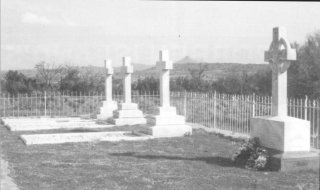
The Lancer graves on Modderfontein Farm, with wreaths laid in 2001 on the occasion of the commemoration of the centenary of the battle. (Photo R W Smith).
Morritt's Grave









